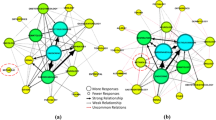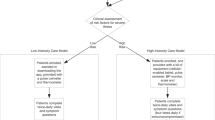Key Points
-
Introduces the concept of managed clinical networks (MCNs).
-
Explains some of the opportunities that MCNs offer.
-
Outlines the advantages of MCNs for patients.
Abstract
Managed clinical networks (MCNs) are self-supporting groups of professionals working together to ensure cross-speciality sharing of patients and expertise. They are a strong mechanism for ensuring that patients receive the care they need in a timely fashion from the most suitable professional in the network area. This short article will explain how they work and how they can work for you.
Similar content being viewed by others
Main
The concept of managed clinical networks arose out of work taking place in Scotland by the Acute Services Review published in 1998. The idea behind the network is to shift emphasis away from buildings and organisations and on to patients and services. The Acute Services Review defined MCNs as 'linked groups of health professionals and organisations from primary, secondary and tertiary care, working in a co-ordinated manner, unconstrained by existing professional and Health Board boundaries, to ensure equitable provision of high quality clinically effective services.'
Established MCNs exist for common chronic conditions and important life stages. The most well established are those for cardiac services, neonatal care and cancer, though MCNs can be established to connect any service where the need exists. MCNs are not statutory bodies but partnerships involving multiple disciplines and professions.
As a method of improving dental services, MCNs in dentistry are supported by the American Association of Endodontists and the British Orthodontic Society. The MCNs work by bringing together dentists with a special interest working in primary care with specialists working in secondary care. They work to make the referral process smoother and less cumbersome. Tayside Orthodontic MCN, identified by the British Orthodontic Society as an example of good practice, involves clinicians and dental care professionals (DCPs) from a range of backgrounds: specialist orthodontists, general dental practitioners with an interest in orthodontics, general dental practitioners (GDPs), community dental practitioners, consultants in dental public health, practice managers, patient representatives, dental nurses, dental technologists and hygienists. They all work together, sharing experience and expertise to improve the provision of services in the Tayside area.
A study from 20051 found that the drive and energy of a lead clinician was vital to the success of a managed clinical network, and that for the same resource allocation the MCN can show demonstrable improvements in the quality of service provided. As important as a dynamic clinical need is to the success of an MCN, just as important is the relationship with, and support of, the primary care trust (PCT) which may help with administrative support. An MCN for dentistry can incorporate existing networks such as local orthodontic networks and other local committees. A full service MCN should strive to cover the full range of services through primary and secondary care to ensure that patient access is maximised. An MCN differs from a regular clinical network by working to evidence-based and outcome measures, and they must also involve patients in the formation of the network.
Training and support
MCNs can offer continuous training and support for GDPs who members. Specialised or more experienced colleagues can mentor more junior colleagues or those who wish to develop their skills in a new area. They can also act as a referring board, using their clinical expertise to judge when treatment is appropriate and whether the referring GDP should be capable of undertaking the procedure. The MCN is a collection of local dental clinicians from a range of specialities working together to maximise local resources. Joining or setting up an MCN will allow the clinician to have access to a network of clinical professionals to make referring easier. Small or single handed practices especially will benefit from the close co-operation that the MCN can offer.
MCNs are a great opportunity for clinicians to come together and create clinically appropriate and achievable care pathways for conditions. MCNs in other clinical specialities have been used to break down traditional barriers by acting as a patient-centred network, taking a holistic view of need. As an MCN will require some level of computerisation it will provide a valuable database of the oral health of the region in which it is based, and this database can also be used by the clinicians to assess their achievements against national indicators. Having a strong relationship with the PCT is an important factor in meeting these costs at the moment, though in the future the local authority may be more relevant.
Using a managed clinical network also has the benefits that a GP consortium brings to general medical practitioners. This can be used to share costs for treatments and for the purchase of equipment, as well as providing a reliable network for locum and DCP sharing.
Patients
The advantages of an MCN for patients are legion, but can be broadly summed up under two themes: access and continuing care. By ensuring that there are many and clear lines of communication between clinicians in an area, the chances of patients being seen quickly by a suitable clinician increase. By ensuring that clinicians are sharing information and have readily available means for doing so, a patient can be happy knowing that even if they see a different clinician, their care is likely to be same as it is referred through the same process. Patient processes are eased by staff all working to the same protocols, and this can also speed up admissions and for medical specialities, ease the pressure on beds. The main role of MCNs is seen as breaking down barriers to ensure that the patient has the care they need throughout their treatment.
How to set up an MCN
A quick internet search or email to your local dental committee should tell you if there is a dental MCN in your area. There are not many MCNs established for dental services at the moment, so interested parties will more often than not have to set up their own. To do this it may be helpful to check if there is an existing MCN in another medical speciality in the area and if so, investigating what local issues they had to face. After this a network of interested dental professionals will be necessary, and the local dental committees may be the easiest way to find these colleagues. Going through the PCT will remain the easiest way to contact colleagues in specialist fields. How many are needed depends on the range of support and services the network is intended to give, but as it becomes more established hopefully it will grow. With the NHS restructuring local networks, collaboration and integration between specialities will become more important. With PCTs set for disestablishment in 2013, it may be more effective to seek financial or other support from local authorities, though while they exist PCTs and strategic health authorities (SHAs) will be valuable sources of support and information. A clear rationale and purpose for the MCN, as well as robust evidence for pathways, will be vital in securing the support of any relevant organisation. More information on setting up an MCN can be found in the March 2003 issue of Royal Society of Medicine's Clinical governance bulletin, available online.2,3,4,5
An MCN offers clinicians of all levels of experience a great opportunity to work in a more constructive environment and ensure that their skills are kept up-to-date, but there are several factors that should be kept in mind if you decide to set up an MCN: it is important to remember that they can take time to implement and even longer to show their full impact. Care must also be taken to ensure that any cross-learning within the MCN is consistent with Department of Health rules on competition.
References
Stc Hamilton K E, Sullivan F M, Donnan P T et al. A managed clinical network for cardiac services: set-up, operation and impact on patient care. Int Integr Care 2005; 5: e10.
Lugon M . Editorial: clinical networks. Clinical Governance Bulletin 2003; 3(6): 1–2. http://www.rsmpress.co.uk/cgbmar03.pdf.
Wall D, Boggust M . Developing managed clinical networks. Clinical Governance Bulletin 2003; 3(6): 2–4. http://www.rsmpress.co.uk/cgbmar03.pdf.
Gorman D, Payne S, Bowers L, Carter H, Donnelly P . Managed clinical networks: developing a strategic approach in NHS Lothian. Clinical Governance Bulletin 2003; 3(6): 4–5. http://www.rsmpress.co.uk/cgbmar03.pdf.
WhoWhatWhere: clinical networks on the web. Clinical Governance Bulletin 2003; 3(6): 6. http://www.rsmpress.co.uk/cgbmar03.pdf.
Author information
Authors and Affiliations
Corresponding author
Additional information
Refereed paper
Rights and permissions
About this article
Cite this article
Skipper, M. Managed clinical networks. Br Dent J 209, 241–242 (2010). https://doi.org/10.1038/sj.bdj.2010.771
Accepted:
Published:
Issue Date:
DOI: https://doi.org/10.1038/sj.bdj.2010.771
This article is cited by
-
An evaluation of referrer factors for 98,671 referrals made to the West Yorkshire oral surgery managed clinical network over a three-year period
British Dental Journal (2022)
-
The development of a restorative Managed Clinical Network within the defence primary healthcare organisation
British Dental Journal (2021)
-
Clinical and academic recommendations for primary dental care prosthodontics
British Dental Journal (2019)
-
Geographic information system mapping of oral surgery referrals to the Birmingham Dental Hospital
British Dental Journal (2019)
-
Enhanced NHS endodontic services in England: a postcode lottery?
British Dental Journal (2019)



